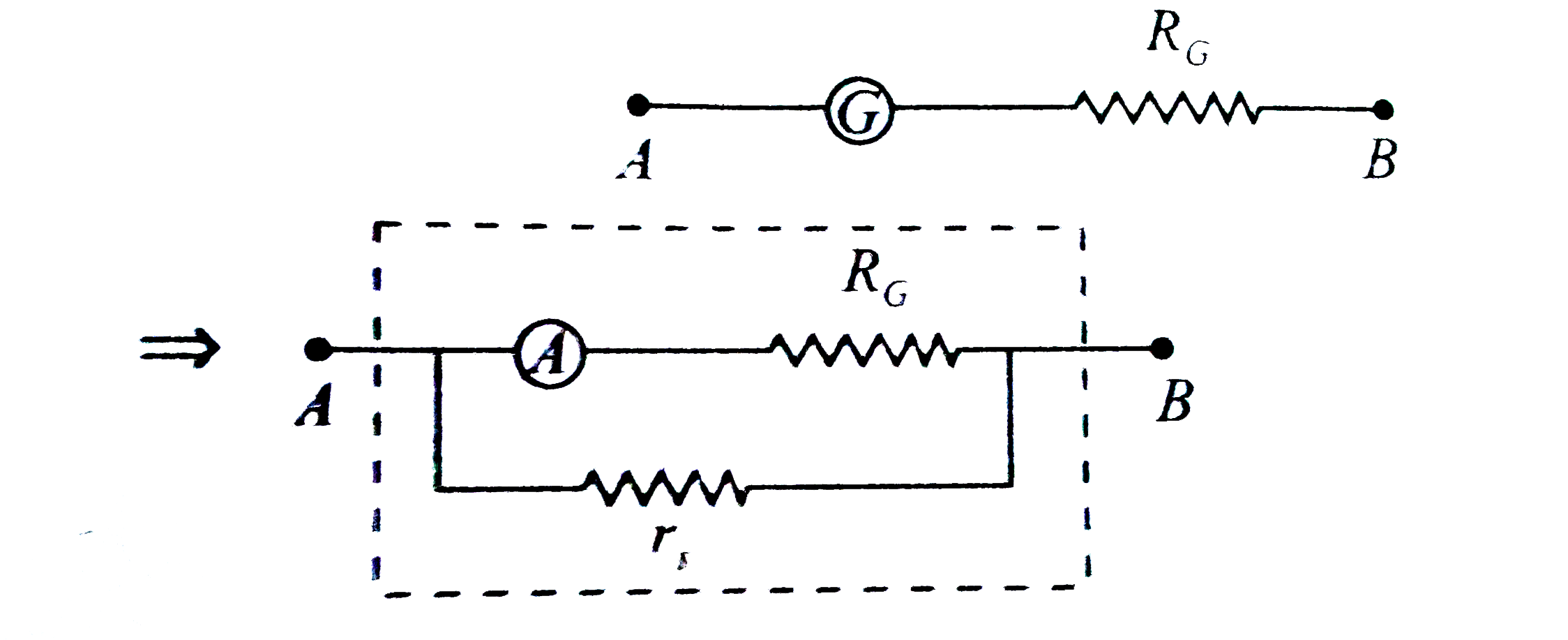A galvanometer can be converted into an ammeter by connecting
introducing a shunt resistance of large value in series.
introducing a shunt resistance of small value in parallel.
introducing a resistance of small value in series.
introducing a resistance of large value in parallel.
The correct Answer is:B
To utilise a galvanometer (G) as ammeter, there is the difficulty in measurnment of current due to the sensitivity of galvanometer and also connection of galvanometer with a very large resistance in series that may change the value of current in the circuit. To overcome these difficulties one attaches a small resistance rs called shunt resistance in parallel with the galvanometer coil as shown in the figure.

Topper's Solved these Questions
- MOVING CHARGES AND MAGNETISM BOOK - NCERT FINGERTPS ENGLISHCHAPTER - MOVING CHARGES AND MAGNETISM EXERCISE - HOTS
5 Videos
- MOVING CHARGES AND MAGNETISM BOOK - NCERT FINGERTPS ENGLISHCHAPTER - MOVING CHARGES AND MAGNETISM EXERCISE - EXEMPLAR PROBLEMS
6 Videos
- MAGNETISM AND MATTER BOOK - NCERT FINGERTPS ENGLISHCHAPTER - MAGNETISM AND MATTER EXERCISE - NCERT Exemplar
5 Videos
- NUCLEIBOOK - NCERT FINGERTPS ENGLISHCHAPTER - NUCLEIEXERCISE - Assertion And Reason
15 Videos
Similar Questions
STATEMENT-1 : Galvanometer can be converted into voltmeter by connecting a large shunt in its series.
STATEMENT-2 : Galvanometer can be converted into an ammeter by connecting a small shunt in its parallel.
STATEMENT-3 : Galvanometer cannot be converted into voltmeter or ammeter.
View SolutionA moving coil galvanometer can be converted into a voltmeter by connecting :
View SolutionState how a moving coil galvanometer can be converted into an ammeter.
View SolutionA moving coil galvanometer, having a resistance G, produces full scale deflection when a current Ig flows through it. This galvanometer can be converted into
(i) an ammeter of range 0 to I0(I0>Ig) by connecting a shunt resistance RA to it and
(ii) into a voltmeter of range 0 to V(V=GI0) by connecting a series resistance RV to it. Then,
View SolutionA galvanometer (coil resistance 99Ω.) is converted into an ammeter using a shunt of 1Ω and connected as shown in figure (a). The ammeter reads 3A. The same galvanometer is convened into a voltmeter by connecting a resistance of 101Ω in series. This voltmeter is connected at, shown in figure (b). Its reading is found to be 45 of the full scale reading. Find :
(a) internal resistance r of the cell
(b) range of the ammeter and voltmeter
(c) full scale deflection current of the galvanometer.

View SolutionA galvanometer can be converted into either an ammeter or a voltmeter. Before conversion, which of the following thing about the galvanometer you are required to know.
i) Resistance of the galvanometer
ii) The magnetic field in which the coil is rotating
iii)Current for full scale deflection of galvanometer
iv) Nature of its construction
View SolutionA galvanometer is to be converted into an ammeter or voltmeter. In which of the following cases the resistance of the device is largest?
View SolutionA galvanometer is to be converted into an ammeter or voltmeter. In which of the following cases the resistance of the device is largest?
View SolutionA galvanometer of resistance 50Ω is converted into an ammeter by connecting a low resistance (shunt) of value 1Ω in parallel to the galvanometer, S. If full - scale deflection current of the galvanometer is 10 mA, then the maximum current that can be measured by the ammeter is -
View SolutionA galvanometer with a resistance of 75Ω produces a full scale deflection with a current of 5 mA. How can this galvanometer be converted into an ammeter which has a range of 0-5A?
View Solution